3 Emerging Market Funds Paying 6.4%, With 30% Upside
 When you think of emerging markets, what comes to mind? Growth opportunities are likely first on the list … followed ever so closely by stomach-churning volatility.
When you think of emerging markets, what comes to mind? Growth opportunities are likely first on the list … followed ever so closely by stomach-churning volatility.
What you probably don’t think about is income. But even in EMs, investors can dredge up some considerable dividend yield.
We all know the basic emerging market investment thesis: These “emerging” countries typically feature much more robust economic growth and quickly expanding middle classes. As a result, the companies there are expected to rapidly grow as they both feed off that greater economic pie, and as their operations become international in nature, building revenues around the rest of the world. Better yet, EMs are a diversified investment, offering returns that aren’t strongly tethered to the U.S. stock market.
With the rewards come the risks: Emerging countries can feature a number of landmines, including less stable geopolitical situations, stock market over-reliance on companies tied to commodities such as oil or gold, less regulated markets and more.
It’s no surprise, then, that dividend yield is one of the last goals on our minds when it comes to EM investments. But while many emerging-market businesses are indeed plowing all available cash into growth, EMs still offer many of the same yield opportunities as developed markets, be it high-dividend stocks in sectors like energy, telecom and real estate, or even junk bonds.
Today, we’ll look at a trio of ETFs that leverage emerging markets with dividends in mind.
SPDR S&P Emerging Markets Dividend ETF (EDIV)
Dividend Yield: 5%
Expenses: 0.49%
The SPDR S&P Emerging Markets Dividend ETF (EDIV) stands out from most typical emerging-market equity ETFs for several reasons beyond its outstanding 5% yield.
For one, many EM funds are grossly overweight China. Take iShares MSCI Emerging Markets ETF (EEM) – the largest emerging-market ETF by assets – for example. A full quarter of EEM’s assets is invested in Chinese companies. Vanguard FTSE Emerging Markets ETF (VWO) has nearly 30% of its weight pushed into China.
EDIV only weights China at about 11% of the fund – still noteworthy, but it’s not even a top-three country. Instead, the overweight to pay attention to is Taiwan, which makes up almost 30% of the fund. South Africa (16%) and Brazil (15%) are the two other double-digit weights here.
Also, while financials (20%) and telecommunications (20%) are the two largest sector holdings – unsurprising for a dividend-focused fund – information technology is a solid 17% of the fund. While tech is very much a high-growth area for dividends, it’s still not exactly teeming with high yields yet. Nonetheless, holdings like 4% yielder RealtekSemiconductor, from Taiwan, pull their weight.
However, a focus on yield has hardly translated into stability for EDIV.
EDIV Still Struggles Despite Attractive Dividends
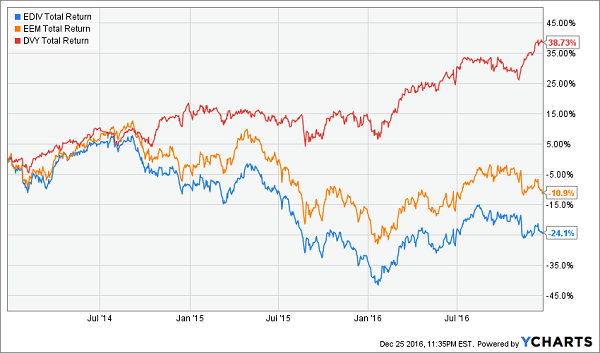
As you can see, EDIV over the past few years has greatly underperformed the stumbling EEM, and it’s not even in the same realm as U.S.-targeted iShares Select Dividend ETF (DVY). While that performance certainly looks better over the past year – EDIV has returned a more-than-respectable 11% to the EEM’s 6% — EDIV’s returns do highlight one of the issues with broader EM equity:
It’s still having a hard time beating the good old U.S. of A.
Guggenheim China Real Estate ETF (TAO)
Dividend Yield: 4.6%
Expenses: 0.7% (Includes fee waiver)
Currently, there is no ideal way of broadly investing in emerging-market real estate investment trusts. While MSCI does offer an index dedicated to tracking a basket of EM REITs – the MSCI Emerging Markets IMI Core REIT Index – no ETFs follow the index. At least not to date.
Global REIT funds are little help too. For instance, the largest EM weight in the SPDR Dow Jones International Real Estate ETF (RWX) is the Philippines at just under 2%, and it’s South Africa at 1.4% in the iShares Global REIT ETF (REET).
But you can still make a pure (albeit concentrated) play on emerging-market real estate via the Guggenheim China Real Estate ETF (TAO), which invests in a basket of nearly 60 Chinese companies. But note that many of the companies in TAO aren’t actually REITs – the fund is full of land development companies or involved in “diversified real estate activities.”
Nonetheless, many of TAO’s holdings, such as non-REITs Hongkong Land Holdings Ltd. and Sun Hung Kai Properties Ltd. (SUHJY), provide significant yield that allow this real estate ETF to boast a yield approaching 5%.
China-Focused TAO Hasn’t Kept Up With U.S. Real Estate
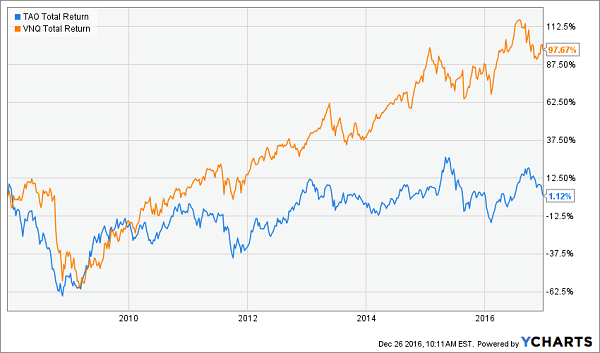
However, anything you might have heard about a Chinese real estate bubble has hardly been priced into the TAO. While the fund has experienced a lot of volatility since inception in December 2007, it has hardly budged – and that’s on a total return basis. Meanwhile, U.S. REITs via the Vanguard REIT Index Fund (VNQ) have doubled during that time.
TAO Holding Its Own in the Short-Term
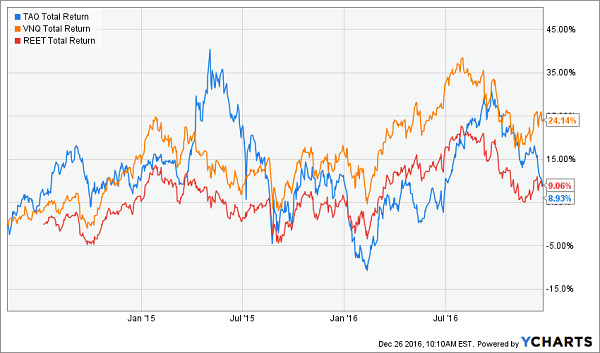
In its defense, however, the fund is at least keeping pace with broader global real estate more recently, at least as measured by the REET ETF.
VanEck Vectors Emerging Markets High Yield Bond ETF (HYEM)
Dividend Yield: 6.4%
Expenses: 0.4% (Includes fee waiver)
Here, we have a winner.
The VanEck Vectors Emerging Markets High Yield Bond ETF (HYEM) is an ETF with a focus that’s not too hard to imagine: sub-investment-grade debt in emerging markets.
But for as risky as that sounds, HYEM does a decent job of tapering off what risk it can. The effective duration of 3.5 years is slightly less than the iShares iBoxx $ High Yield Corporate Bond ETF (HYG) and the SPDR Bloomberg Barclays High Yield Bond ETF (JNK).
Better still is the spread of countries represented in this index. Chinese (13%) and Brazilian (10%) junk bonds make up nearly a quarter of the fund. But past that, another 18 countries are represented between 9% and 1% of the fund, with a host of others falling under that, grouped as … well, “other.” The debt spans the globe, from Kazakhstan to Indonesia to Venezuela to the United Arab Emirates, exposing you to a widespread swath of the emerging world.
HYEM Looks Like an Emerging-Market Winner
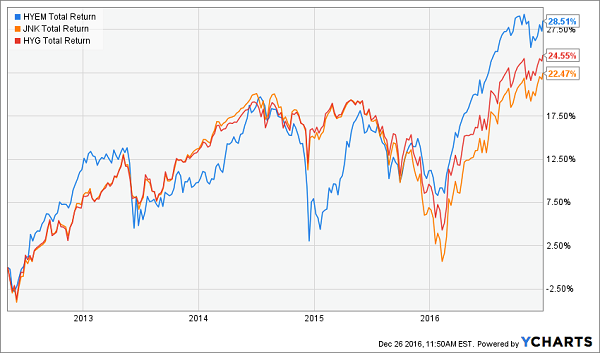
Unlike EDIV and TAO, HYEM has delivered on the performance front. Yes, emerging-market junk debt has experienced slightly more dramatic swings than its U.S. counterparts, HYG and JNK. However, the result – at least since inception in 2012 – has been a few percentage points of outperformance.
In fact, HYEM has been one of the best ways period to invest in emerging markets over the past few years.
Each of these emerging-market ETFs offers diversified income that might be able to buoy your portfolio if American stocks take a turn. HYEM in particular is an extremely interesting vehicle that has proven its worth since coming to market – and a sound 6%-yielding investment should not be ignored.
Which is why it’s downright foolish to ignore my favorite stock right now.
Study after study shows that investors simply don’t have enough socked away for retirement. That’s because we’re all living longer, and because most investment options aren’t returning what we need to lead full, comfortable lives in retirement – in fact, many investments will barely pay for the necessities!
Consider this: Let’s say you have a half-million dollars invested for retirement. If you think bonds will get you to the finish line, think again! That’ll earn you $15,000, maybe $16,000 every year.
No, you need to be making around 8% every year, which provides about $40,000 annually, to fund the kind of lifestyle you’d actually want to have in your post-career years.
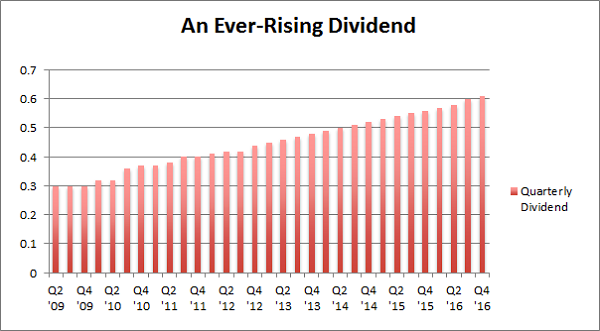
That’s where my favorite dividend stock comes in. This no-brainer winner already yields 8.5%, and it raises its dividend not every year, but each and every quarter! Tack on the projected capital gains on this sure-fire pick, and you’re looking at a total return 17% between dividends and capital gains every single year!
Don’t sleep on the ETF picks above by any means. But if you’re looking for a sure-fire dividend pick for 2017 and beyond, let’s talk.
I specialize in uncovering contrarian 8%+ income opportunities like my ever-rising dividend pick. Click here and I’ll explain more about my strategy and my favorite stocks and funds to buy for a secure retirement on just $500,000.
Category: Dividend ETFs




